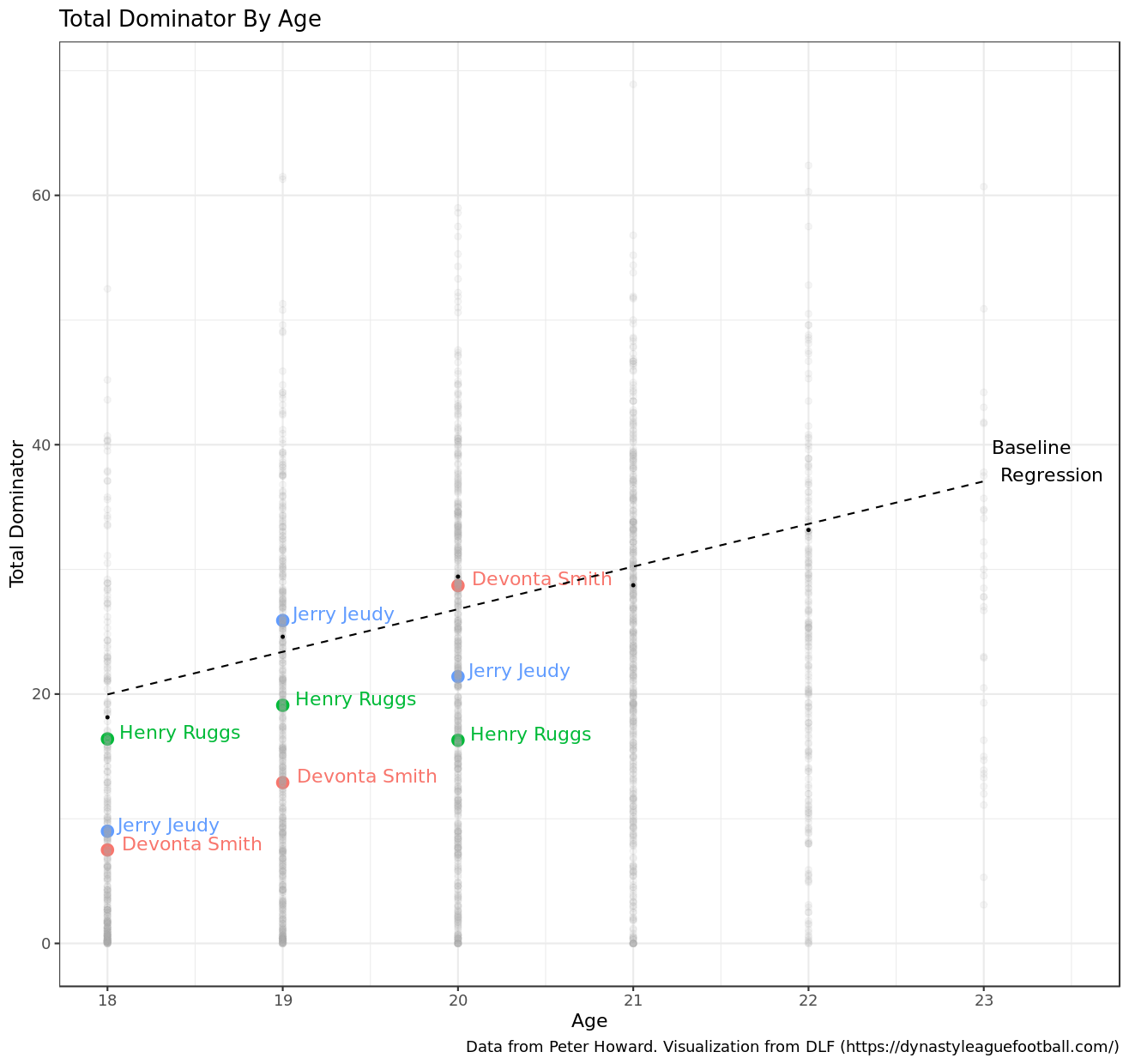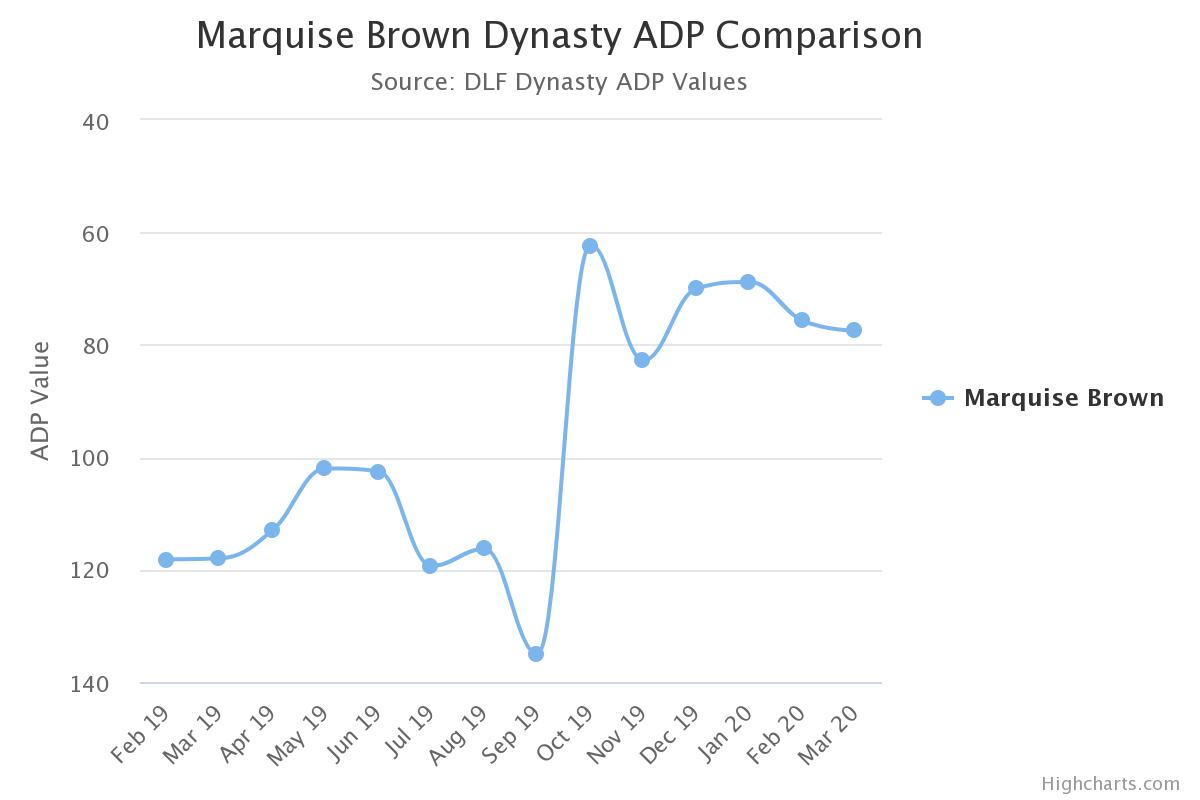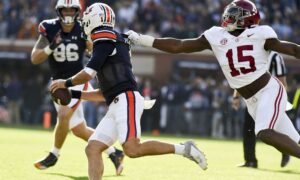2020 NFL Draft Prospect – Henry Ruggs, WR Alabama
Our NFL rookie profile series continues with this analysis of 2020 NFL Draft Prospect Henry Ruggs, WR from Alabama. We will continue to provide you with these in-depth rookie profiles and a ton of other fantasy football rookie analysis right up through the NFL Draft. Stay tuned, and stay ahead of your league!
Henry Ruggs is one of the more polarizing players in this class at any position. Some film analysts absolutely love him and consider him among the elite in a really strong wide receiver class, while some see him more as a one-trick pony – a player who has elite speed and can stretch the field but does little else effectively. Then, you have the data analysts, who point to his production profile and illustrate how Ruggs is a low-probability selection in rookie drafts.
I like to consider tape, production and metrics, and athleticism in my pre-draft evaluations, so I’ll attempt to combine all three to display a complete picture of an exciting player. Let’s dig in.
THE STATS


Statistics from sports-reference.com.
Let’s start with the return production.
Punt returning requires more creativity than kick returning; a player needs to be able to survey the landscape in front of him while using his vision to follow blocks right as or before they develop. For lack of a better term, it also requires good wiggle, and Ruggs isn’t that elusive without open field in front of him. Because of this, it’s not entirely surprising that Ruggs had mediocre production here.
However, his lack of production as a kick returner makes little sense. For a player with elite speed like Ruggs, one would expect far greater productivity on kick returns than Ruggs’ modest statistics. Across 25 kick returns, Ruggs averaged just 21 yards per return and did not score once. 25 returns is a small sample, but it leads me to believe that he’s not particularly creative with the ball in his hands. I’ll get into this a bit later.
His production as a receiver has been hotly debated. In 2017 as a true freshman, Ruggs scored six touchdowns on 12 receptions. He hardly got playing time, but his limited usage hinted at a massive ceiling.
Then, as a sophomore, Ruggs had what looks like meager production overall, but he finished 13th in the SEC in receptions, yards, and yards per reception, and ranked second in the SEC in receiving touchdowns with 11. Alabama had five players in the top 16 in yards in the SEC in 2018 – Irv Smith was a top tight end prospect and an exciting young player in the NFL, Jerry Jeudy and Ruggs will be first-round picks this year, and Devonta Smith and Jaylen Waddle are next up in 2021. His junior season also saw him in the top ten in the conference in both yards and touchdowns.
Ruggs finished his Alabama career third on the school’s career touchdown receptions list with 24. Essentially, Ruggs was still a solid, yet unspectacular performer in the toughest collegiate conference in the nation.
However, more advanced statistics show more of a cause for concern. In essence, players who have a production profile like his have not panned out at the NFL level with much success, and betting on Ruggs to buck this trend would require betting on an outlier, which is generally poor process. In addition, Ruggs never broke out, which is a massive red flag. I don’t want to undersell these points, because they’re valid.
There are some caveats, though.

First, Alabama regularly rests its starters after halftime of blowout victories, of which there are many. This doesn’t affect his market share statistics in comparison to his fellow starters, but it lowers the overall slice of the pie that the starters get to share since the reserves get ample opportunity later in games. It also makes his counting stats look weaker than other top receivers in the class at other programs.
Second, Alabama receivers have played “Rock, Paper, Scissors” on the field before a play to decide who was going to run a specific route on certain plays. Again, this isn’t to make excuses for Ruggs’ poor production – but it’s worth noting that things could have easily swung in another direction.
Finally, Peter Howard wrote an outstanding article outlining the positive data arguments of Ruggs’ profile a few weeks ago. It is valuable context to reference when considering the blanket analysis performed with certain metrics (i.e. breakout age, dominator rating, etc.). Please read the entire article linked above to gain a clearer picture, but a couple of his main takeaways I found interesting are below:
- Henry Ruggs, at 18 years old, was a bigger part of Alabama’s offense than CeeDee Lamb was at Oklahoma.
- Henry Ruggs was the WR3 for his team, but he was putting up a level of production that was similar to a WR2 on most teams in the SEC.
- In comparison to historical college teams with three or more future NFL wide receivers, Ruggs was scoring at the rate of the WR2 – or WR1 for some teams, if we compare him to the NFL talent on Clemson between 2011 and 2013, during their NFL talent heavy era. We’re talking about DeAndre Hopkins-level points, or at least Sammy Watkins-level points, with Adam Humphries-level volume here. That’s not just hard to do, it’s incredibly impressive.
This is not to dismiss the concerns with Ruggs’ profile. Not one player drafted in the first round with his statistical profile in the last decade could really be considered a hit, and that is extremely worrisome.
THE FILM
https://www.youtube.com/watch?v=ZsOZEwZXDn0
His speed is a trait you simply cannot teach. If you press Ruggs and he beats you, it’s game over. His speed forces defensive backs to give him a cushion at the line of scrimmage unless a safety is shaded that way over the top. One of Ruggs’s most effective routes is the dig or comeback because corners get threatened along a vertical stem before he quickly drops his hips and breaks back towards the line of scrimmage suddenly.
https://twitter.com/RecruitAlytics1/status/1217900265619304449
Ruggs shouldn’t be categorized as a physical receiver, but he doesn’t shy away from contact. He will look to maximize yardage every time he has the ball in his hands, and often that means putting his foot in the ground, getting upfield, and taking on contact. He is able to eat up ground after the catch because of his speed and is an asset – although not a creator – with the ball in his hands. Ruggs absolutely destroys pursuit angles.
Henry Ruggs III (reported 4.25 40) is as explosive as they come🧨 On this play which was called back he was clocked at 23.27MPH – BLAZING SPEED
Tyreek Hill has the fastest in-game speed over the last 3 seasons – 23.24MPH – the play was called back as well.
Both plays ⬇️ #devy pic.twitter.com/OecxWRSTgH
— Ray G (@RayGQue) June 12, 2019
Ruggs is also a surprisingly good technician with the ball in the air – he has terrific body control and good (and huge) hands. He was effective in the red zone due to these traits despite not being the top option in his offense. Ruggs is not a contested-catch technician, but he competes and has the traits to develop in this area, even if his frame suggests a limited ceiling here. He dropped just five passes in his career at Alabama.
A good number of Ruggs’ touches were manufactured. This can certainly be taken as a negative, as his production would have been even more limited without these – but generally, explosive players and transcendently talented players are the two types of players who tend to have plays designed specifically for them. Even if you don’t think Ruggs is transcendent, he is undoubtedly explosive. He is the type of weapon that smart offensive play-callers can scheme touches to and plays for, and is one of the main reasons he’s likely to be an early first-round pick in the NFL Draft.
Ruggs frequently is compared to Tyreek Hill, but to me, the similarities begin and end with their long speed. Hill is more agile and accelerates to his top speed faster, and is much quicker on a lateral plane than Ruggs. However, both excel when given touches near the line of scrimmage and given the freedom to create yards after the catch, and both are effective lid-lifters.
When it comes to the negatives, I don’t see much that points to a bad player. Ruggs is lean, and can occasionally struggle to uncover against press and physical cornerbacks who are able to get an effective punch in at the line of scrimmage. Similarly, his releases show flashes of brilliance but are too inconsistent for him to defeat press regularly.
Because NFL DBs are more athletic than collegiate ones, Ruggs is probably going to see more press at the pro level because more corners will be able to recover from potential mistakes faster than college kids will. As mentioned above, he was also schemed into space often to avoid getting contacted by defensive backs right off the line. Learning to develop physicality throughout a route will help him transition to the next level.
THE MEASURABLES
The NFL Scouting Combine is a good opportunity for analysts to see if a player’s testing differs greatly from what they’ve shown on film. When a player runs a much faster 40 in Indianapolis than expected based on what their long speed looks like on tape, the Combine presents an opportunity to go back to the film and reevaluate to see if something was missed. Sometimes, the opposite happens, where a player runs much slower than expected.
With Ruggs, neither was the case. He blew up the Combine, as most people expected him to.
First, Ruggs measured in at 5’11”, 188 pounds, which is just under what he was listed at on Alabama’s roster (6’0”, 190). We then learned he has short arms (13th percentile among receivers) but huge 10.13” hands (90th percentile).
His elite speed and burst is readily apparent on tape, and he backed up his film with his testing numbers. Expected to challenge John Ross’s 2017 record, Ruggs ran “just” a 4.27-second 40, adding on with a 42 inch vertical and a 131” broad jump – all good for 94th percentile marks and above. After showing his ridiculous burst and explosion, he bowed out of the rest of the tests, so we don’t have agility drills or times for Ruggs.
Some of his comparable players are intriguing. Per MockDraftable, his top comparison is someone named Edmond Gates, whom I have never heard of. Second, third, and fifth on the list, though, are Santonio Holmes, Corey Coleman, and Santana Moss, respectively. Holmes looked like a future star before tailing off with the Jets, and Moss had a very solid, long career. Both would be intriguing comparisons to contrast with the Mike Wallace/DeSean Jackson/Tyreek Hill ones frequently associated with Ruggs. Similarly, Corey Coleman was a tremendous prospect on paper – he had draft capital, production, and athleticism; he simply failed to pan out, and I am still sad about it.
DYNASTY VALUE
This is where things get complicated.
Scouts, film analysts, and the league seem to really like Ruggs as a prospect, so he’s likely to be drafted inside the top 20 of the NFL Draft next month. Having said that, he’s not a good prospect at all from a data perspective. We know that film and data analysts occasionally have wildly contrasting opinions on players, and Ruggs is a perfect example of that.
Ruggs is currently being drafted towards the end of the first round in 1QB rookie drafts (1.10) and in the early second of superflex and 2QB rookie drafts (2.02). He profiles as a much better real-life NFL player than dynasty asset, in part due to his likely week-to-week volatility. Our rookie rankers currently slot him in as the ninth rookie overall (1QB format), with a range between sixth and 12th overall. He’s between the WR4 and WR7.
Ruggs is currently 85th off the board in March startup mock drafts, so he’s on the seventh and eighth round borderline at the moment. This makes him the current WR41. Almost all first-round rookie receivers have insulated value, so I don’t expect Ruggs to come much cheaper than this, barring a horrific landing spot that scares everyone off.
However, we saw a similar situation play out with Marquise Brown last year. Brown was the first receiver off the board in the NFL Draft, but a combination of his size, landing spot, and injury concerns caused him to slip in rookie drafts. Ruggs is a similar archetype of player and could have a fall that mirrors Brown’s post-draft scenario closely. Having said that, this is what Brown’s ADP has done over the last year. His lowest point was September – when the season started. Since then, he’s risen dramatically and remained relatively static since then.

Even if you don’t believe in Ruggs long-term, he should have stable value at the beginning of his career.
Conclusion
I like Henry Ruggs III, and I want my favorite NFL team to draft him. Every NFL team would benefit from having an explosive, downfield threat in their passing game. Ruggs is going to be an infinitely better NFL player than fantasy asset, and that’s okay. DeSean Jackson is one of the most underrated wide receivers of this era; one that has consistently proven to improve the play of the quarterback he’s teamed up with. Will Fuller is another player who shifts how defensive coordinators have to game plan for an offense. Their presence on the field tilts coverage even when they’re not being targeted.
Ruggs is this type of elite field stretcher; however, despite this, the role itself is not one that projects safely to consistent fantasy output because of the volatility of the targets that player gets. Deep threats typically see fewer passes, and because of the elevated depth of target from the line of scrimmage, these passes are completed less frequently.
Ultimately, I think I like Ruggs more than most. He’s currently my 1.12 and WR7 in 1QB rookie rankings. Having said that, I think he is best suited to be a complementary piece of an offense – like he was at Alabama – that can have spike games and change the way defensive coordinators game plan. I think his ceiling is along the Brandin Cooks/TY Hilton plane, but I think his floor is significantly higher than a Darrius Heyward-Bey type that never showed anything – and the result will likely fall somewhere in the middle. Landing spot will play a big role in determining how he pans out.
- Preseason Week One Dynasty Takeaways: Part Two - August 18, 2021
- Preseason Week One Dynasty Takeaways: Part One - August 18, 2021
- 2021 Rookie Class: An Early Look at Terrace Marshall, WR LSU - January 26, 2021


































































